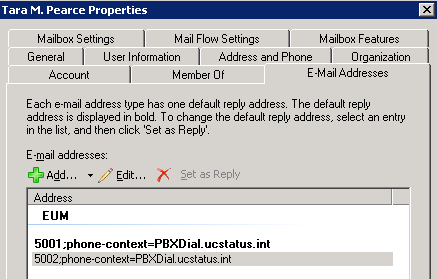Exchange 2007 UM - Transfer to Voicemail
I was recently working with a Customer who wanted to transfer calls to voicemail directly without ringing the phone first. We discussed a couple different options.
1. Adding additional EUM Proxy Address to each users mailbox.
This would give the flexibility of routing a call directly to Voicemail for any user without ringing the phone line.
The down side to this approach is having to assign and remember two extensions for each user. Also having to route additional extensions thru the phone switch / PBX to UM for each user.
2. Route calls through the PBX with Diversion / History-Info to UM.
This can be implemented by creating an extension such as 7XXXX. So any extension with a preceding '7' would get routed with Diversion / History-Info to UM.
Example from a Asterisk PBX might look like this:
exten => _7XXXX,1,Answer
exten => _7XXXX,n,SipAddHeader (Diversion:<tel:${EXTEN:1}>)
exten => _7XXXX,n,Dial(SIP/EXCH_UM/${SA-NUM})
exten => _7XXXX,n,Busy
Again this solution would require some programming from the PBX in order to implement this solution. This would not require any additional configuring on Exchange UM to implement this solution.
3. Create an Auto Attendant that only forwards calls to Exchange UM for voicemail.
This is done by creating an Auto Attendant, using your normal process. But I will take you through how this gets created and what the customer discovered that works for them.
New-UMAutoAttendant -Name VoiceMail -SpeechEnabled $False -Status Enabled -UMDialPlan PBXDial -PilotIdentifierList 4606
This will create your Auto Attendant, but we will still need to make a couple more modifications to Auto Attendant.
Set-UMAutoAttendant -Identity VoiceMail -AllowExtensions $False -CallSomeoneEnabled $False -SendVoiceMsgEnabled $True -NameLookupEnabled $False
When calling into the Auto Attendant now you will hear the following:
"Welcome to the Microsoft Exchange Auto Attendant. Enter the extension for the person you are calling."
When you dial the Extension / Voicemail Number. You will then be taken directly to Voicemail with out ringing any phone lines.
In the customers environment, they now call an extension associated with the newly created Auto Attendant. They are prompted for a users extension. Then transferred to the users Mailbox to leave a message.
I must give credit to the Customer for coming up with Option 3. This seemed to answer their needs and work in their environment.
Comments
Anonymous
December 27, 2010
Thanks Geoff for the great write-up. I was working with a consultant for implementing the 3rd option above in an 2010 environment. The command by itself disables the AA because when one disables AllowExtensions, CallSomeoneEnabled and NameLookupEnabled; it disables the UM AA completely. In 2007 the error was not thrown and hence user would assume the command is working. In 2010 the error thrown when you try the exact same command is "The auto attendant shouldn't be changed to have all options disabled. To disable an auto attendant, use the "Disable-Autoattendante" cmdlet." So, the workaround I did was to use the following command. It worked in customer's environment but they found it little cumbersome. However, at this point, we don't have a documented solution and this is the best we can implement. Set-UMAutoAttendant -Identity VoiceMail -AllowExtensions $False -CallSomeoneEnabled $True -SendVoiceMsgEnabled $True -NameLookupEnabled $False Thanks, Kaushal Mehta Sr. UC/UM Escalation blogs.technet.com/.../kamehtaAnonymous
December 10, 2013
Geoff, I am wondering if you ever got option 1 to work. We have a client who might be interested, but I can't seem to get it working. I defined an additional extension inside of UM but no matter what I do, the call will not route directly to UM. I call inside of Lync and it just tries to dial outside world because it's not defined inside of Lync. Was this something that was done as an, in theory just should work or something that was actually done and working? If so, how do I get Lync to see the additional extension as something to route to UM? Thanks Matt
